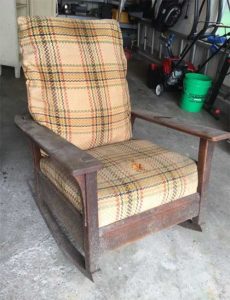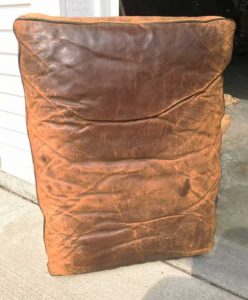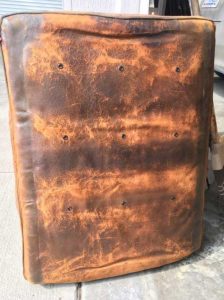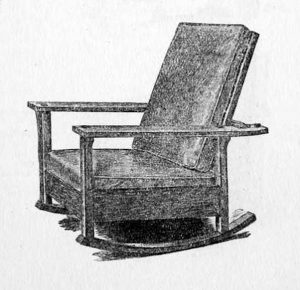Small Home Gazette, Summer 2019
What to do With an Original Leather Cushion
 Q: I found this rocker at an auction. At the time it looked like it does in this photo. After removing the grime with mild soap and water, the finish is beautiful. Under the ugly 1970s re-upholstery job was the original 100-year-old leather. The seat was totally fried, and I had to throw it away because the top was gone and the sides crumbled in my hands. The springs and frame look almost new.
Q: I found this rocker at an auction. At the time it looked like it does in this photo. After removing the grime with mild soap and water, the finish is beautiful. Under the ugly 1970s re-upholstery job was the original 100-year-old leather. The seat was totally fried, and I had to throw it away because the top was gone and the sides crumbled in my hands. The springs and frame look almost new.
 The top cushion leather is in better condition, but the sides of the upholstery are turning to powder and crumble as you touch them. Do I have to save this cushion as is, or can I replace the leather and maintain the value of the chair? I want to make the chair usable.
The top cushion leather is in better condition, but the sides of the upholstery are turning to powder and crumble as you touch them. Do I have to save this cushion as is, or can I replace the leather and maintain the value of the chair? I want to make the chair usable.
A: Thanks! This is a great question, as it comes up often.
First, congratulations on not stripping and refinishing your L. & J.G. Stickley rocker. A careful cleaning of the original finish should be followed with a coat of quality paste wax to preserve the finish without altering its appearance.
As for the cushions, I would carefully place the back cushion in a plastic garbage bag, then label it for storage. Obviously, it cannot be used, but it should be preserved so that it can always remain with the rocker. You should show it to your upholsterer so that he/she can duplicate it accurately.
As for the drop-in seat, I would also take the frame and springs to your upholsterer, but do some research first. Find a photograph in an online auction catalog, exhibition catalog, or reprint of an L. & J.G. Stickley catalog which shows what the original cushion would have looked like. Make a copy and leave it with your upholsterer.
In this way, you and your upholsterer can duplicate the original appearance of the seat and back cushions, making it possible for you, your family, and your guests to use your Stickley rocker. And at the same time you have preserved what was left of the original cushion so that it can travel forward in time with the rocker.
Thanks again for writing!
Article reprinted with permission of ArtsAndCraftsCollector.com. Bruce Johnson is an author, columnist and Director of the National Arts & Crafts Conference at The Grove Park Inn.
Editor’s note: We followed Johnson’s advice and looked for leather and cushion information in the L. & J.G. Stickley Handicraft Furniture catalog, circa 1910. We found the following:
“Leather. For covering chairs, settles and table tops, we employ goat skins imported from Turkey, or where these are not large enough, carefully selected cow hides.
 Cushions. Our spring seat cushions for chairs and settles are built on steel bands securely fastened to wooden frames,… These seat cushions are removable and slip easily into place. They are exceedingly comfortable, the cushions keep their shape, and the leather lasts much longer than in a springless cushion. The back cushions are ventilated through air holes. When pressure is applied to the cushion, the air is expelled; when relieved of pressure, the cushion becomes filled with air, which penetrates the filling and keeps it from becoming matted.”
Cushions. Our spring seat cushions for chairs and settles are built on steel bands securely fastened to wooden frames,… These seat cushions are removable and slip easily into place. They are exceedingly comfortable, the cushions keep their shape, and the leather lasts much longer than in a springless cushion. The back cushions are ventilated through air holes. When pressure is applied to the cushion, the air is expelled; when relieved of pressure, the cushion becomes filled with air, which penetrates the filling and keeps it from becoming matted.”












